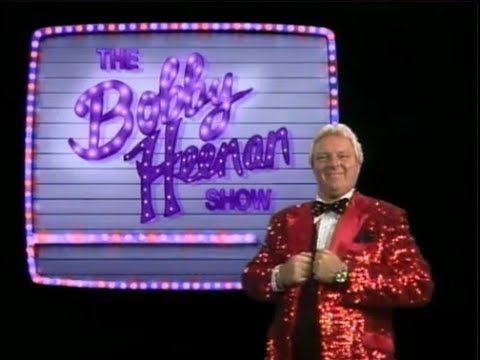American https://en.wikipedia.org/wiki/Professional_wrestling https://en.wikipedia.org/wiki/Manager_(professional_wrestling), https://en.wikipedia.org/wiki/Color_commentator, and wrestler. He performed with the https://en.wikipedia.org/wiki/American_Wrestling_Association (AWA), the https://en.wikipedia.org/wiki/World_Wrestling_Entertainment (WWF, now WWE) and https://en.wikipedia.org/wiki/World_Championship_Wrestling (WCW) under the https://en.wikipedia.org/wiki/Ring_name Bobby "the Brain" Heenan. Heenan was known for his skill in elevating https://en.wikipedia.org/wiki/Heel_(professional_wrestling) on-screen talent by drawing https://en.wikipedia.org/wiki/Heat_(professional_wrestling) for himself and his wrestlers from the crowd. He was paired with numerous wrestlers, including https://en.wikipedia.org/wiki/Nick_Bockwinkel, whom he led to win the https://en.wikipedia.org/wiki/AWA_World_Heavyweight_Championship, and he became an integral figure in the https://en.wikipedia.org/wiki/1980s_professional_wrestling_boom by managing https://en.wikipedia.org/wiki/King_Kong_Bundy and https://en.wikipedia.org/wiki/Andr%C3%A9_the_Giant in WWF main event matches with https://en.wikipedia.org/wiki/Hulk_Hogan at https://en.wikipedia.org/wiki/WrestleMania_2 and https://en.wikipedia.org/wiki/WrestleMania_III respectively. The wrestlers under his tutelage were collectively known as "https://en.wikipedia.org/wiki/The_Heenan_Family" at various times throughout his career. Known for his quick wit and comedic ability, Heenan also served as a color commentator and is remembered for his on-screen repartee with https://en.wikipedia.org/wiki/Gorilla_Monsoon. Outside of wrestling, Heenan authored two books, appeared on numerous television shows, and briefly hosted a parody talk show titled The Bobby Heenan Show on https://en.wikipedia.org/wiki/WWF_Prime_Time_Wrestling. Heenan retired in 2001 at https://en.wikipedia.org/wiki/WrestleMania_X-Seven after a seventeen-year stint as a commentator in professional wrestling but he continued to make sporadic appearances in several promotions. In 1965, Heenan became a regular in William Afflis' (known by his in-ring persona https://en.wikipedia.org/wiki/Dick_the_Bruiser) Indianapolis-based https://en.wikipedia.org/wiki/World_Wrestling_Association_(Indianapolis) under the moniker "Pretty Boy" Bobby Heenan. In 1966, he wrestled his first match against Calvin "Prince" Pullins. Heenan said he was never trained as a wrestler and it came naturally. He was booked – both as a manager and wrestler – after the promoters saw how well he handled the physical aspects of his managerial duties. During his time in WWA, he managed https://en.wikipedia.org/wiki/Angelo_Poffo and https://en.wikipedia.org/wiki/Chris_Markoff, the Assassins (https://en.wikipedia.org/wiki/Guy_Mitchell_(wrestler) and Joe Tomasso), https://en.wikipedia.org/wiki/The_Valiant_Brothers and https://en.wikipedia.org/wiki/The_Blackjacks. In particular, Heenan was credited with making https://en.wikipedia.org/wiki/Blackjack_Lanza one of the top wrestling villains in the country. This impressed promoter https://en.wikipedia.org/wiki/Sam_Muchnick, who typically hated wrestling managers, and Heenan is believed to be the only heel manager to work in Muchnick's https://en.wikipedia.org/wiki/St._Louis_Wrestling_Club. He also occasionally wrestled with a storyline "brother" Guy Heenan, portrayed by Guy Mitchell, from the Assassins. In 1974, he left the WWA. He attributed his departure to a dispute with Afflis over pay for his participation in the first-ever wrestling event held at https://en.wikipedia.org/wiki/Market_Square_Arena, emphatically stating that he never returned to the promotion as a result. After leaving WWA, Heenan announced he was now to be known as "The Brain" at his AWA debut in 1969. He took up managing the team of https://en.wikipedia.org/wiki/Nick_Bockwinkel and https://en.wikipedia.org/wiki/Ray_Stevens_(wrestler), a duo which won a third https://en.wikipedia.org/wiki/AWA_World_Tag_Team_Championship under his leadership. While Bockwinkel and Stevens feuded with The Crusher and Dick the Bruiser, Bruiser famously called Heenan "Weasel"; this led to his rivals calling him "Weasel" throughout the rest of his wrestling career. The AWA was the starting point for the first incarnation of his eponymous heel https://en.wikipedia.org/wiki/Stable_(professional_wrestling), The https://en.wikipedia.org/wiki/Heenan_Family, which initially consisted of Bockwinkel, Stevens, https://en.wikipedia.org/wiki/Bobby_Duncum_Sr., and Blackjack Lanza. On January 25, 1975, an angry fan fired a gun at Heenan in Chicago's https://en.wikipedia.org/wiki/International_Amphitheatre after Heenan interfered in one of Bockwinkel's matches. Heenan was unharmed, but five people sitting ringside were injured, one of them critically. Later in 1975, Bockwinkel captured his first of several https://en.wikipedia.org/wiki/AWA_World_Heavyweight_Championship, ending the seven-year reign of perennial champion and AWA promoter https://en.wikipedia.org/wiki/Verne_Gagne. While Bockwinkel was AWA Champion in 1976, Lanza and Duncum captured the AWA World Tag Team Championship, making Heenan the first manager in history to simultaneously manage both a major promotion's singles and tag team champions. In 1984, Heenan left AWA to join the https://en.wikipedia.org/wiki/World_Wrestling_Federation (WWF). While most of the AWA talent left for the WWF during this time without giving proper notice (the AWA required departing talent to work a six-week notice for booking and https://en.wikipedia.org/wiki/Broadcast_syndication-based reasons, with most talent claiming that WWF promoter https://en.wikipedia.org/wiki/Vince_McMahon paid them extra not to work out their notices with the AWA), only Heenan worked out his notice in good faith to the Gagne family. He was written out of AWA television when https://en.wikipedia.org/wiki/Wally_Karbo announced on the September 28 broadcast of https://en.wikipedia.org/wiki/AWA_All-Star_Wrestling that Heenan had been suspended indefinitely by AWA President Stanley Blackburn for initiating an attack on https://en.wikipedia.org/wiki/The_Fabulous_Ones by Heenan Family members Nick Bockwinkel and https://en.wikipedia.org/wiki/Mr._Saito.
Heenan was signed by the WWF in 1984 with the intention of him managing https://en.wikipedia.org/wiki/Jesse_Ventura, however Ventura's retirement due to blood clots in his lungs prevented this from happening. Instead, Heenan managed https://en.wikipedia.org/wiki/Big_John_Studd (whom Heenan was best friends with in the AWA) in his feud against https://en.wikipedia.org/wiki/Andr%C3%A9_the_Giant. Studd challenged André to a https://en.wikipedia.org/wiki/United_States_dollar15,000 bodyslam match at the first https://en.wikipedia.org/wiki/WrestleMania_(1985), with the stipulation being that André would have to retire had he lost. Heenan and the Heenan Family had a feud with https://en.wikipedia.org/wiki/Hulk_Hogan in the 1980s, and Heenan managed two https://en.wikipedia.org/wiki/WrestleMania challengers to Hogan's title. In 1986, Heenan managed King Kong Bundy in his main event bout at https://en.wikipedia.org/wiki/WrestleMania_2. During the https://en.wikipedia.org/wiki/Andr%C3%A9_the_Giant%E2%80%93Hulk_Hogan_rivalry preceding https://en.wikipedia.org/wiki/WrestleMania_III, André sided with Heenan and challenged Hogan at the event. While neither Bundy nor André won the title at that time, André later bested Hogan for the championship on https://en.wikipedia.org/wiki/The_Main_Event_I on February 5, 1988, in a controversial win after he aligned himself with https://en.wikipedia.org/wiki/Ted_DiBiase. Part Coming Next
mostra meno

